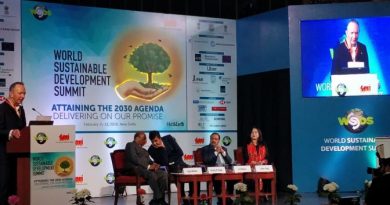Only ‘Nature-Based-Solutions’ entail restoration of the ecosystem services
The World Environment Day encourages reflection on our individual & collective actions' impact on the planet and compels us to adopt 'nature-based solutions' (NbS) to protect habitats and mitigate climate change.


The paradox of modern society is that the most important issues are often least talked about. The World Environment Day offers an opportunity to all of us to reflect on whether our individual or collective actions benefit the planet or make things worse for it. This important day also reminds us that understanding how natural forces work, their interconnections, and developing ‘nature-based solutions’ are inalienable if we are committed to protecting our natural habitats and mitigating the imminent threats of climate change.
A Peek Into The Past
The World Environment Day event was first celebrated in 1972 in Sweden often termed as “Stockholm Conference on Human Environment” in the history of UNEP. Each year there’s usually a different theme and different host country for the global celebration, though Bangladesh has been an exception to host the event nine times, while hosting for eight consecutive summits in a row (from 1977 till 1984).
In last fifty three years, the World Environment Day has discussed various issues concerning the global environmental degradation and possible catastrophes including Human Environment to Human Settlements, Water to Ozone Layer Environmental Concern – Land Loss & Soil Degradation, Destructive Development to Only One Future for Our Children to Ground Water; Toxic Chemicals in Human Food Chain to Managing & Disposing Hazardous Waste; Acid Rain & Energy, Desertification to Youth; Population and the Environment to Global Warming; Global Warning to Climate Change; Need for Global Partnership to Poverty and Environment – Breaking the vicious Circle, For Life on Earth to Save Seas to save trees to Air pollution to Water scarcity to Green cities to Melting ice. From species extinction to rising sea levels to forests to plastic pollution, year over year, we’ve discussed and themed the year on a wide number of environment related themes. 2024 offers us a renewed opportunity to do some retrospection and some introspection – has the situation changed for good or has it rather worsened?
Have we been able to build resilience against climate change or global warming? Have we secured Water for seven billion people? Have we been able to reverse the extinction of species? Have we achieved the goals that we’ve set for ourselves?
Returning to Roots
UNEP works closely with its 193 member countries apart from NGOs, civil society, businesses and stakeholders in order to undo the harm caused to the environment due to anthropogenic activities as well as address environmental challenges through the UN Environment Assembly, the world’s highest-level decision-making body on the environment.

The travesty that hounds us is that we haven’t been able to build the basic understanding about our environment, i.e., Soil, Water and Air. We haven’t developed clear understanding on how these elements are interlinked with each other and impact all factors in the vicinity from ground Water to temperature to rainfall to humidity to biodiversity to agriculture to diseases to flood to droughts and all other factors termed as ‘natural calamities.’ And since the basic fundamentals aren’t understood well, the obvious is what we see around: the implementation is naturally not as impactful as it could have been.
Today, we’re trying to deal with each problem in silos, while all the problems are interlinked and connected. We saw the same issue in COP summits too, twenty-eight of them have happened with last one happening in Dubai last year. But the progress has been miniscule, compared to the mighty force of nations joining in. We advocated in the COP 28-Dubai as well that the world & the world leaders to work on the path and pace correction too. We can’t work on only emission reduction; because switch over form fossils to renewable wouldn’t happen overnight and we don’t have the luxury of time today. We need to parallelly work on sequestration and creating carbon sinks as well.
Similarly, for the World Environment Day, it’s high time that we realize that all can be set right with ‘Nature- based Solutions,’ provided the path is correct. We’ve been taking the wrong approach based on physics, chemistry and biology (or microbiology), but we know that the environmental problem is an ecological issue for which physics, chemistry and biology are the subsets, therefore the results would be limited and short lived.
Do Not Fall For Misconceptions About Nature-based Solutions
Similarly, for Nature-based Solutions (NbS) as well, there’s a lot of misunderstandings and myths all around. Often people mistakenly take biological / microbiological intervention as nature-based approach, while it is not. Like genetically modified seeds or cloning are not nature-based solutions, similarly inducing a lab grown organism isn’t a nature-based solution. Let’s understand it from a different perspective, let’s say if you have a pest or rodent problem in the house. What are the possible solutions?
- You put a mouse trap, catch the mouse and leave them in the jungle away from home. That’s the physical intervention. A slow process with lacunas, with low effectiveness
- You get the chemical-based pest control done, and after the spray the mouse will die wherever they get in contact with the chemical and the home will be filled up with decaying smell of dead rat bodies. That’s chemical intervention. Now, you get busy in shifting the entire house to find out the dead bodies to dispose them off, and may be get exposed to the strong chemical fumes yourself as well.
- And then comes the biological approach, you leave ten deadly snakes in the home, who will catch hold of the rats and eat them up for good. But would you be able to live along with the deadly poisonous snakes in the same home? Though the solution was biological, but was that sustainable?
That’s what happens when the path is incorrect.
A Nature-based Solution (NbS) is sustainable and holistic, only when it works on the basic principles of nature and life. The most sustainable phenomenon on the planet is nature itself, and it doesn’t have any concept of waste or wealth, thus any process that leaves any waste residue, can’t be in harmony with nature. For example, in an STP, sludge is the waste residue, in Smog tower, collected PM is the waste residue. Thus, these aren’t sustainable processes.
Respect Wholesomeness of Natural Environment
Nature is cyclic and we just need to restore the cycle. For example, if we plan to restore a waterbody, which is the conjunction point of Soil, Water and Air, our approach shouldn’t be to clean or beautify it. Rather, the efforts should be to restore the ecosystem services that come from them.
The exchange between the layers of Soil, Water and Air, gives birth to the ecosystem services, which solves plethora of problems including, Aquifer Correction and Recharge (UNSDG 13), Flood and Drought Mitigation and avoiding water logging in the vicinity (UNSDG 11), Maintaining a healthy aquatic life, and aquatic food chain (UNSDG 14), Consumption and Digestion of the nutrients ensuring the phenomena of eco-dredging through which the bottom deposits of sludge get consumed and the natural water holding capacity gets maintained (UNSDG 6), Photosynthesis within the aqua-ecology by autotrophic microbes resulting carbon sequestration and oxygenation of the atmosphere in the vicinity, also creating a blue carbon sink (UNSDG 13), Maintaining low ambient temperature in the vicinity to nullify UHI and PVHI effects (UNSDG 11), Air pollution mitigation (UNSDG 11), Water Pollution mitigation (UNSDG 6), Biodiversity conservation (Above and below Water) (UNSDG 14 & 15), Safeguarding the vicinity from outbreak of Water and vector borne diseases (UNSDG 3), Restoring ambient temperature in the vicinity (UNSDG 13), and Making highly potent water available for aquaculture, agriculture and animal husbandry (UNSDG 8).
Let’s take a pledge for path correction and understand the nature this World Environment Day!
The writer is founder of Vaidic Srijan and an NbS expert.





We have enough water to feed everyone on the earth using very efficient capturing of the same, other than DAMs, barrage, reservoirs, but by harvesting rain water with the large variety of Geosynthetics available in the country…we export over 90% of them being manufactured here..